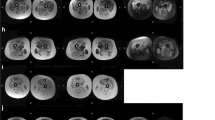Abstract
Of the seven autosomal dominant genetically distinct forms of LGMD so far described, in only four the causative gene has been identified (LGMD1A-1D). We describe clinical, histopathological and muscle MRI features of a large Italo-Spanish kindred with LGMD1F presenting proximal-limb and axial muscle weakness. We obtained complete clinical data and graded the progression of the disease in 29 patients. Muscle MRI was performed in seven patients. Three muscle biopsies from two patients were investigated. Patients with age at onset in the early teens, had a more severe phenotype with a rapid disease course; adult onset patients presented a slow course. Muscle MRI showed prominent atrophy of lower limb muscles, involving especially the vastus lateralis. Widening the patients population resulted in the identification of previously unreported features, including dysphagia, arachnodactyly and respiratory insufficiency. Muscle biopsies showed diffuse fibre atrophy, which evolved with time, chronic myopathic changes, basophilic cytoplasmic areas, autophagosomes and accumulation of myofibrillar and cytoskeletal proteins. The LGMD1F is characterized by a selective involvement of limb muscles with respiratory impairment in advanced stages, and by different degrees of clinical progression. Novel clinical features emerged from the investigation of additional patients.





Similar content being viewed by others
References
Gamez J, Navarro C, Andreu AL et al (2001) Autosomal dominant limb-girdle muscular dystrophy: a large kindred with evidence for anticipation. Neurology 56:450–454
Palenzuela L, Andreu AL, Gamez J et al (2003) A novel autosomal dominant limb-girdle muscular dystrophy (LGMD 1F) maps to 7q32.1-32.2. Neurology 61:404–406
Dubowitz V, Sewry CA (2007) In. Muscle biopsy: a practical approach , 3rd edn. Saunders Elsevier, Philadelphia
Stramare R, Beltrame V, Dal Borgo R et al (2010) MRI in the assessment of muscular pathology: a comparison between limb-girdle muscular dystrophies, hyaline body myopathies and myotonic dystrophies. Radiol Med 115:585–599
Starling A, Kok F, Passos-Bueno MR, Vainzof M, Zatz M (2004) A new form of autosomal dominant limb-girdle muscular dystrophy (LGMD1G) with progressive fingers and toes flexion limitation maps to chromosome 4p21. Eur J Hum Genet 12:1033–1040
Hauser MA, Conde CB, Kowaljow V et al (2002) Myotilin mutation found in second pedigree with LGMD1A. Am J Hum Genet 71:1428–1432
Van der Kooi AJ, van Meegen M, Ledderhof TM, McNally EM, de Visser M, Bolhuis PA (1997) Genetic localization of a newly recognized autosomal dominant limb-girdle muscular dystrophy with cardiac involvement (LGMD1B) to chromosome 1q11-21. Am J Hum Genet 60:891–895
Cenacchi G, Peterle E, Fanin M, Papa V, Salaroli R, Angelini C (2013) Ultrastructural changes in LGMD1F. Neuropathology. doi:10.1111/neup.12003
Harms MB, Sommerville RB, Allred P et al (2012) Exome sequencing eveals DNAJB6 mutations in dominantly-inherited myopathy. Ann Neurol 71:407–416
Sarparanta J, Jonson PH, Golzio C et al (2012) Mutations affecting the cytoplasmic functions of the co-chaperone DNAJB6 cause limb-girdle muscular dystrophy. Nat Genet 44:450–455
Hackman P, Sandell S, Sarparanta J et al (2011) Four new Finnish families with LGMD1D; refinement of the clinical phenotype and the linked 7q36 locus. Neuromusc Disord 21:338–344
Bisceglia L, Zoccolella S, Torraco A et al (2010) A new locus on 3p23-p25 for an autosomal-dominant limb-girdle muscular dystrophy, LGMD1H. Eur J Hum Genet 18:636–641
Torella A, Fanin M, Mutarelli M, et al (2013) Next-generation sequencing identifies Transportin 3 as the causative gene for LGMD1F. PLoS One (in press)
Acknowledgments
The authors wish to thank all the family members who promoted meetings for neuromuscular examination and blood sample collection. This work was supported by grants from the Association Française contre les Myopathies (13859 to MF, 14999 and 16216 to CA) and the Telethon Italy (GTB12001 and GUP10006 to CA and GUP11006 to UN).
Conflicts of interest
The authors declare that they have no conflict of interest.
Author information
Authors and Affiliations
Corresponding author
Rights and permissions
About this article
Cite this article
Peterle, E., Fanin, M., Semplicini, C. et al. Clinical phenotype, muscle MRI and muscle pathology of LGMD1F. J Neurol 260, 2033–2041 (2013). https://doi.org/10.1007/s00415-013-6931-1
Received:
Revised:
Accepted:
Published:
Issue Date:
DOI: https://doi.org/10.1007/s00415-013-6931-1




